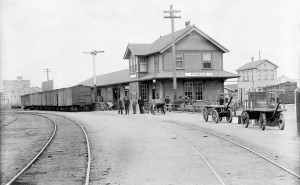Graniterock's Historic Watsonville Railroad Depot
Posted by Rose Ann Woolpert on Mar 18, 2015

Watsonville’s Historic Railroad Depot is one of the few depots still remaining of the many built by the Southern Pacific Railroad during California’s glory days of train travel. The structure itself has been almost unchanged since it was built in 1895, and is a wonderful reminder of the rich history of train travel in our region. Trains and rail transport have been a part of Graniterock history since 1876, when a deposit of granite rock was first discovered by railroad surveyors as they prepared to lay track along the Pajaro River Gap between Watsonville and San Juan Bautista. Since then, narrow and standard gauge steam locomotives, diesel engines and fleets of rail cars have helped to transport crushed granite rock within the A.R. Wilson Quarry and beyond to construction sites throughout California.
In 1871, the Southern Pacific Railroad built a railroad station to connect Watsonville, a town of just a few thousand residents, with the rest of the region. Local farmers and fruit packing houses shipped their strawberries, apples and other fruits and vegetables by rail. The first Watsonville Depot no longer stands.Watsonville’s second depot, a "Two Story Combination Depot No. 22", was the most frequently built depot of standard design. The Southern Pacific adopted more than two dozen "Common Standards" for depots, locomotives, cars and their accoutrements, and colors and placement were precisely dictated. Of about ninety built in California between 1894 and 1916, only a handful with this particular floor plan survives today and none remain in active service.
On the main floor of the building were areas typical of railroad depots: a ticket sales counter, an area to check baggage, a telegraph bay and a small attached warehouse for freight. These features were incorporated into most of Southern Pacific's standard designs, and Watsonville’s depot also has a cooler room once used for apple storage. Compact living quarters for the station agent and his family were located on the second floor at the top of a winding staircase. Bay windows in the station master’s private rooms allowed clear views of arriving and departing trains. The depot is built from clear heart redwood lumber milled from the trees of the Santa Cruz Mountains, and its solid construction withstood the force of both the 1906 and 1989 earthquakes.
Southern Pacific painted its wooden depots in the standard colors of colonial yellow, dark yellow and medium brown, with a moss green roof and white window sashes. These colors became "trademarks" for the Southern Pacific, similar to today’s “golden arches”. One day in the future, the Watsonville Depot will be repainted in its original color scheme.
In 1936, Granite Rock Company moved its Corporate Offices from Watsonville’s Maple Avenue to 411 Walker Street, adjacent to what was then a busy S.P. Depot. By the 1970s, freight and passenger rail service had declined dramatically, and the depot building was sold to Graniterock for use as a storage facility, which it remains to this day.
Back to all Blogs
